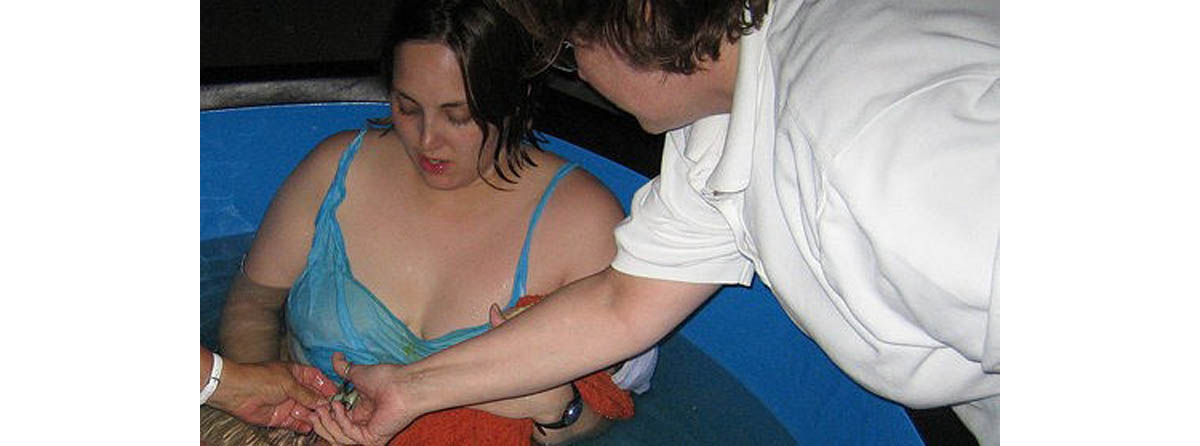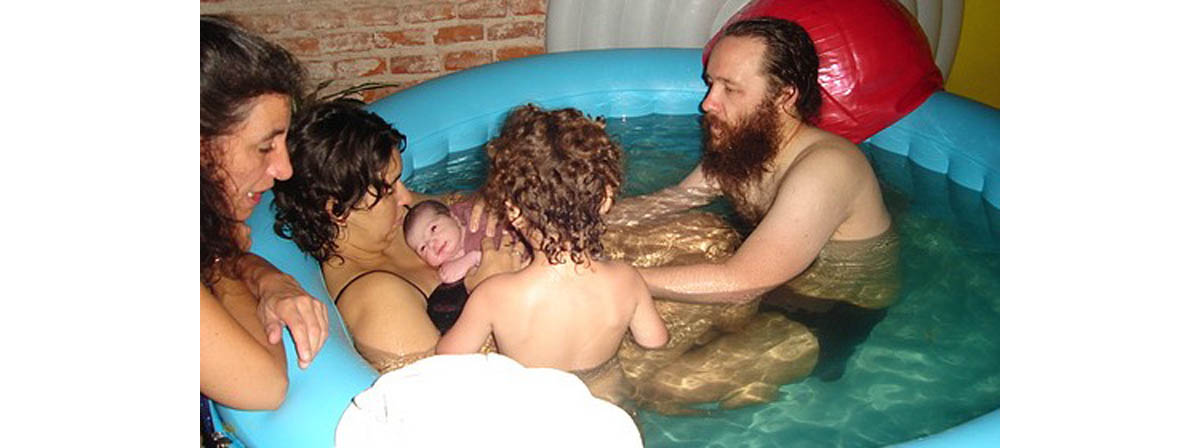What do you picture in your mind when you hear the words "labor and delivery" — or rather, perhaps, how would these words make you feel before you ever contemplated getting pregnant and having a baby? Chances are that you aren't conjuring up images of a pool, aromatherapy, dimmed lights and back massages. But who says that giving birth cannot be a little like a spa experience?

More and more hospitals, birth centers and home birth midwives are offering special birthing pools. Women who have gone through labor and sometimes also the birth of their baby in a birthing pool tend to be very positive about the experience, saying the water offers pain relief and has a calming effect.
Are you curious yet? Those expectant folks who want to know more about waterbirth (usually spelled as one word, but also sometimes as two separate words) will no doubt want to know if the practice is safe, above all else. Once that has been addressed, we will take a look at the benefits and drawbacks of waterbirth — and how women who chose this option experienced their labors and births.
Is Waterbirth Safe?
Many pregnant women in the early stages of labor naturally find their way to their shower or bath for distraction and pain relief. Waterbirth takes this age-old practice one step further; being much bigger and heated, birthing pools allow the laboring mother to almost completely immerse herself in inviting warm water, with plenty of space to move around. Laboring women are usually encouraged to wait until their labor is well established before entering the birthing pool.
So, how safe is this practice? Will babies who are born into water drown as they attempt to take their first breath? Many women experience spontaneous bowel movements during the final stages of labor — will a pool contaminated with fecal matter endanger a newborn baby? How about contaminants from previous mothers, in the case of commercial pools in hospitals or that your midwife brings with her? Can these pools really be cleaned effectively? And how about fetal monitoring in the birthing pool?
Midwives who assist in waterbirths explain that babies who are born into a birthing pool will not drown due to the so-called "dive reflex". A fetus is immersed in amniotic fluid during pregnancy, and he or she will not start breathing until first contact with air occurs. However, for this to work, the mother must be immersed in such a way that the baby will not come into contact with air during crowning.
Babies routinely come into contact with bacteria from the mother's vagina during any vaginal delivery. This "colonization" process is actually beneficial, since the baby has already received antibodies to these bacteria during pregnancy, and will continue to do so through breastfeeding. Waterbirth does not change this process, proponents say — a baby will be exposed to the same set of microorganisms when born into water as they would have during a vaginal birth, except now there's water, too.
Birthing pools need to be thoroughly cleaned and disinfected between births. Disposable covers are also available. Women who are considering a waterbirth in a non-hospital environment need to question their midwife about the cleaning process, but birthing pools are considered safe as long as they are properly disinfected.
Water-proof fetal monitoring equipment has become available as waterbirths are increasing in popularity. Many midwives use more low-tech methods like a fetoscope or asking the mother if fetal movement is occurring to monitor the fetus during labor.
Some studies conclude that the practice is safe during low-risk, normal pregnancies. Many hospitals and birth centers across Europe see waterbirth as safe for low-risk pregnancies and offer it as an option to women.
At the same time, a 1999 study warned against the risk of drowning, or near-drowning with pneumonia and infections as a result. However, the study was referring to home baths and hot tubs in non-planned situations, not to specialized birthing pools.
Is waterbirth safe? We can logically conclude that laboring while immersed in water is not dangerous, as long as your pool is clean. Giving birth while immersed in a birth pool requires a little more caution. Every pregnant woman who is interested needs to review the available evidence and ensure that she is satisfied with the credentials and experience of her midwife or midwives. Back-up obstetric care with access to an operating theater and neonatal intensive care is always helpful.
Waterbirth Benefits And Disadvantages
The Benefits Of Labor And Birth In Water
Proponents of waterbirth have a rather long list of purported benefits. They include a more relaxed birthing environment for the mother, less pain (water slows down contractions and acts as natural pain relief), and a feeling of being in control. Mothers can, they say, change positions more easily when they are weightless within the tub.

Waterbirth International, which promotes waterbirths, says that laboring in water reduces maternal blood pressure, reduces the risk of vaginal tearing or an episiotomy, and lowers the c-section rate. Waterbirth is easier on mothers than land birth, they say, and provides a gentle welcome for babies.
But what do real women say? Jenny has one child.
Jenny decided to get out of the tub to give birth. She was restless and had enough of the water, but she says she would labor in a tub again if she had another baby.
Dahlia had a homebirth. The midwife-provided pool was ready for her after she had been in active labor for a while. "The contractions in the tub were definitely less intense than those out," she shares. "I gave birth squatting in the tub."
Gwen gave birth in a hospital, assisted by midwives. She got in the birthing tub even later on in her labor than Dahlia, but will never forget the experience. "I entered the tub when I hit transition," she explains. Just before pushing, in other words.
Women who have waterbirths also often say that their babies were very calm after birth. Some believe that the water forms a more natural transition from womb to world than a land birth does.
Disadvantages Of Waterbirth
Not everyone likes the experience of waterbirth. "I had the option of laboring in a tub, but it didn't help me at all," Nicky said. She said the birth pool was shallow — something that even waterbirth advocates say is dangerous — and that her midwives encouraged her to stay in even when she made it clear she wanted to get out.
The moral of the story? Probably that experiences will vary individually, and that pregnant women want to make sure they won't have to contend with a midwife "pushing" her own agenda while they are pushing their baby out.
Beside the obvious fact that not all laboring women are going to enjoy the experience of being immersed in water, there are some practical difficulties as well. The pool takes a long time to fill and then needs to be maintained at the right temperature for the duration of a mother's stay in the pool. If the pool is too hot, this can lead to overheating issues.
Walking around is one thing that speeds up labor or gets it going, but women who are using a pool do not have this option.
Those who are giving birth in the pool should have their lower body completely immersed. If the baby's head hits the air and then dips back into the water, there is a huge drowning risk. Finally, I have to mention it — the risk of fecal matter at your baby's birth site.
It's completely normal to have a bowel movement during the pushing stages of labor. During a land labor, the clean-up does not cause a lot of problems. I've heard stories of midwives simply "scooping the feces out" during a waterbirth — with a fish net! — as if this could possibly get rid of all fecal matter.
I personally wouldn't want to bath in my own, uhm, bowel movement and I don't like the thought of my baby being there either. So, if an "accident" does occur during labor, it is probably time to get out of the pool.
- Photo courtesy of richie graham by Flickr : www.flickr.com/photos/lincolnlog/20769676/
- Photo courtesy of rabble by Flickr : www.flickr.com/photos/rabble/4417531562/


Your thoughts on this